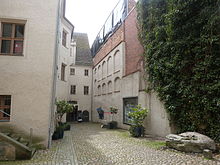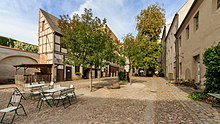Cranach courtyards

The so-called Cranach Höfe are located in Wittenberg . In 1505, Elector Friedrich the Wise summoned the painter Lucas from Kronach in Franconia to his Wittenberg court. Cranach lived in Wittenberg for 40 years , where he left lasting traces as one of the most versatile personalities of the Reformation period . There are two of his houses in the city, in which his workshops and workplaces were. In these historically interesting monuments of the Renaissance , the history of one of the most famous citizens of Wittenberg is combined with the building history of two houses.
Market 3 and 4
Cranach initially lived in the painter's room in the castle, but in 1512 acquired the properties at Markt 3 and 4 in Wittenberg. Cranach probably married in 1512 and moved to the market with his family. Here he built the most successful painting workshop of his time. Around 1517/18 he sold the property, but bought back Markt 4 in 1522 in order to set up the printing company founded with his business partner Christian Döring . This resulted in prints with world significance, including Luther's New Testament in German, the so-called September Testament .
The building is considered to be the birthplace of Lucas Cranach the Younger and Benedikt Carpzov , the founder of German criminal law. After his father's departure, Lucas Cranach the Elder was in charge. J. continued to run the workshop independently and successfully. From 1533 to 1535 the building was completely renovated. The arched longitudinal corridor on the ground floor and the window frames date from the Cranach period. In 1541 the house was given to the son-in-law Lucas Cranach the Elder. J., Caspar Pfreundt, who set up a pharmacy in the property.
The rococo style dominated the redesign around 1771. The third floor was raised and the lower attic was expanded. Further changes in the 19th and 20th centuries led to the fact that one can only speculate about the room layout in the Cranach period. During the extensive restoration of the ensemble from 1995 on, valuable Renaissance paintings were discovered on the ceilings and walls. The Cranach Foundation shows temporary exhibitions in the rooms on the ground floor and the first floor. The courtyard has also become a lively place for handicrafts, trade and communication.
In 2009 the renovation of the Cranach courtyards, which had been abandoned by the GDR authorities, was completed. In the future, students from a youth art school will find accommodation in the converted front building of the Renaissance ensemble.
Schlossstrasse 1
In 1517/18 Cranach acquired what was then the largest Wittenberg farm at Schlossstrasse 1, which he rebuilt and added a side wing to accommodate the workshop. In 1520 he received the pharmacy privilege. In the pharmacy he set up in this property, he traded sandstone, paper, paints, sugar, wax, spices and wine.
In 1540 Lucas Cranach the Elder had the house and property rebuilt according to his ideas. While the front building was reserved for residential purposes, the left side wing housed the book printing company founded by Cranach and Christian Döring. The famous painting workshop was located in the transverse building that ends the courtyard of the house. According to tradition, Cranach's “painter's academy” is said to have been housed in 84 heatable rooms and 16 kitchens. After the house became the property of Lucas Cranach the Elder in 1544. J. came, some renovations took place in the late 16th century. Two dormitories from this period on the eaves side were destroyed during the siege of 1760. Renovation work was carried out in 1773, and six years later the “Churf. Saxon. Privil. Apotheke zum Adler ”, which has been housed in the Markt 4 building since Cranach's time and to which the eagle relief on the northeast corner refers. The building was only given a third floor in 1830. After severe fire damage in 1871, there were further structural changes. The passage portal was moved to the west end of the house. In the middle of the courtyard there is a tube water fountain and on November 27, 2005 the monument to Lucas Cranach the Elder was erected. Ä. inaugurated by the sculptor Frijo Müller-Belecke .
In 2005 the Cranach-Höfe were declared a monument of national importance.
literature
- Lucas Cranach the Elder Ä. and the Cranachhöfe in Wittenberg. ed. from the Cranach Foundation. Halle / Saale: Mitteldeutscher Verlag 1998. ISBN 3-932776-09-7
Web links
- Lucas Cranach and Höfe Cranach Foundation

